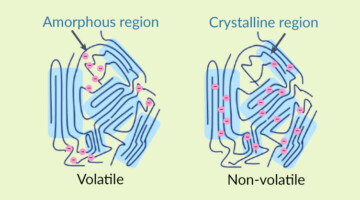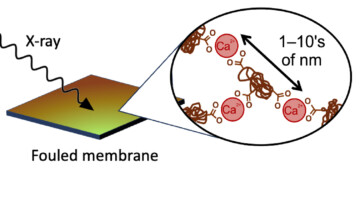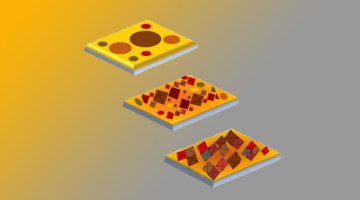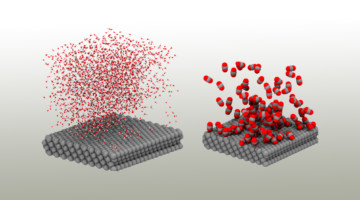When the lattice-matched 2D perovskite BA2FAPb2I7 (red) is incorporated into a yellow-phase FAPbI3 matrix (yellow), the 2D crystallites present a perovskite-like surface, which serves as a template for the FAPbI3 to convert to its photoactive phase (black). The resulting phase-stabilized FAPbI3 shows substantially improved optoelectronic properties and exceptional stability under 85°C and sunlight. Read more »
How Bulky Molecules Improve Next-Generation Solar Cells
Adding “bulky” organic molecules earlier in solar-film synthesis slows crystal growth, leading to the formation of a protective surface layer that improves durability and efficiency. These next-gen materials could revolutionize solar-cell technology, offering increased efficiency, lower cost, lighter weight, and flexible solar modules. Read more »![]()
![]()
An Organic Transistor That Can Sense, Process, and Remember
Traditional AI hardware employs physically separated information sensing, processing, and memory architecture, a configuration that suffers from large energy and time overhead. Now, researchers have fabricated an organic transistor device that can simultaneously act as the sensor and processing core of a streamlined AI hardware system. Read more »
Keeping Water-Treatment Membranes from Fouling Out
When you use a membrane for water treatment, junk builds up on the membrane surface—a process called fouling—which makes the treatment less efficient. In this work, researchers studied how membranes are fouled by interactions between natural organic matter and positively charged ions commonly found in water. Read more »
Electric Vehicle Batteries Could Get Big Boost With New Polymer Coating
Scientists have developed a conductive polymer coating—called HOS-PFM—that conducts both electrons and ions at the same time. This ensures battery stability and high charge/discharge rates while enhancing battery life. The coating also shows promise as a battery adhesive that could extend the lifetime of a lithium-ion battery from an average of 10 years to about 15 years. Read more »
Surface Charge and Nanoparticle Chromophore Coupling to Achieve Fast Exciton Quenching and Efficient Charge Separation in Photoacoustic Imaging (PAI) and Photothermal therapy (PTT)
Organic semiconductor nanoparticles (OSNs) convert absorbed light into heat, and are commonly used in photothermal therapy and photoacoustic imaging. Here, the OAN, Y6, is shown to form strong intermolecular packing, manipulated by surface charge under restrained sizes, yielding new pi-pi stacking and fast exciton quenching. The temperature of the tumor area can rise to more than 70 degrees under NIR irradiation, which can effectively ablate a tumor. Read more »
Versatile Sequential Casting Processing for Highly Efficient and Stable Binary Organic Photovoltaics
Ideal bulk heterojunction morphology is critical in organic solar cells (OSCs). Here, researchers show how sequential casting improves device performance in both fullerene- and nonfullerene-based systems, in which the donor and acceptor are deposited sequentially. The film spin-coating method is analogous to the traditional Chinese pancake-making process. Read more »
A Split-Screen View of Solar-Cell Crystallization
Researchers simultaneously monitored both the structure and function of a photovoltaic material as it crystallized from solution. The work raises the prospect of rationally tuning materials for optimal performance in photovoltaics and other light-manipulating devices, including light-emitting diodes, detectors, and lasers. Read more »![]()
![]()
New Technique Paves the Way for Perfect Perovskites
A new solar material, organic-inorganic halide perovskites, could one day help the U.S. achieve its solar ambitions and decarbonize the power grid. A recent study reports that manufacturing could be aided by a new instrument that uses invisible x-ray light and visible laser light to probe a perovskite material’s crystal structure and optical properties as it is synthesized. Read more »
Exquisitely Selective CO2 Reduction on Silver
Researchers electrochemically reduced CO2 to CO with nearly perfect selectivity over other products by adding an organic compound to the surface of a silver electrode. With theoretical analyses and ALS data, the work revealed the key role of the microenvironment in promoting the conversion of CO2, a greenhouse gas, into useful products. Read more »![]()
![]()
- 1
- 2
- 3
- 4
- Next Page »









